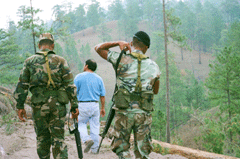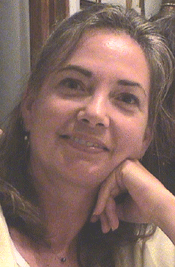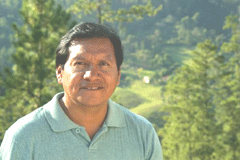Liberation Ecology
Air Date: Week of September 21, 2007

Father Andres Tamayo of Honduras, accompanied by two of his bodyguards. Father Tamayo is under 24-hour protection. (Photo: Marilyn Snell)
In Latin America, Catholic priests and nuns are confronting loggers and miners from multinational companies on behalf of the poor. Host Steve Curwood talks with Sierra Magazine writer Merilyn Berlin Snell about her recent article, “Bulldozers and Blasphemy.”
Transcript
CURWOOD: It’s Living on Earth. I’m Steve Curwood. The Vatican recently declared that it is becoming the world’s first carbon-neutral state, thanks to the donation of carbon credits from a reforestation project in nearby Hungary. The move follows the Pope’s call for the international community to respect and encourage a green culture. And nowhere is that call being answered more than among activist Roman Catholic priests and nuns in Central America. In Guatemala and Honduras Catholic leaders are taking on multinational loggers and mining companies on behalf of the poor, sometimes at the risk of their very own lives.
Marilyn Berlin Snell traveled to Central America to report on this story for Sierra Magazine, and she joins us now. Welcome to Living on Earth.
SNELL: Hello
CURWOOD: Now, in your article you write mostly about Honduras and Guatemala, countries that are rich in such natural resources as gold and timber, yet more than half of the population there lives below the poverty line. What’s going on?

Political map of Central America. (Photo: Energy Information Administration www.eia.doe.gov)
CURWOOD: You spent a fair amount of time looking at some of the mines. Tell me what you saw in the area around the Marlin mine in Guatemala.
SNELL: The Marlin mine is in the highlands of western Guatemala and it’s almost 100 percent indigenous there. When the company- it was a Canadian company- came in around 2003, they offered to buy homes. These people are very poor, many of them sold their land. But nobody knew what open pit mining was and they got a rude awakening when the development started. They were blasting entire sides of mountains. I visited homes that were literally cracked in half because the blasting was happening too close to villages. They took me down to their farming plots and showed me where their sheep and cattle had died because they said they had drank contaminated water. And this is a huge mining operation. It just literally has sheered off entire sides of a mountain.

Sierra Magazine writer Marilyn Snell. (Courtesy of Marilyn Snell).
SNELL: When I was in Honduras I went to the Department of Olancho. And there a priest named Father Andres Tamayo lives and works. He founded an environmental organization some years ago to try and protect the forest in his region from both illegal logging and logging that is legal but is fairly rapacious because there’s very little oversight. And when Father Tamayo took me out into the forest to show me what was going on—it was pretty depressing. The loggers basically use bulldozers to push down anything in their way. Trees are taken from right from the edge of creeks, which contributes to the erosion that causes problems during heavy rains. There’s nothing left on the ground. It’s so parched because there’s no more canopy that very little can grow.

Father Andres Tamayo from Honduras has had his life threatened because of his work to stop illegal logging. (Courtesy of the Goldman Prize Foundation)
SNELL: Father Tamayo works with communities, with local people, to organize, sometimes get in the street, on the highways, and block these logging trucks. It’s very, very dangerous work. He also works in association with other Catholic groups around the country to—right now they’re trying to reform the forestry law. And Father Tamayo said he was hoping for some kind of reform within a year.
CURWOOD: Could you please describe Father Tamayo for me? In fact, maybe take me through the day that you visited him. What was it like to be with him and what is he like as a person?
SNELL: I got there and he was conducting a wedding ceremony in a very tiny cinderblock church in one of the villages he presides over. He was clearly a very popular man, quite jovial, and when he came out of the church he changed into an Amnesty International t-shirt. He’s on their watch list actually. And just said, “let’s go see what they’ve done to the forest.” So he got in his truck with three of his military bodyguards and he went out ahead and I followed him in another truck and we went out to the forest and fortunately he didn’t tell me until after we came back that last year this was where snipers had tried to kill him and instead killed a colleague that was next to him in the car. He told me that everyday he expected it would be his last. But he didn’t have a choice. This is what he felt that he had to do.

Father Andres Tamayo of Honduras, accompanied by two of his bodyguards. Father Tamayo is under 24-hour protection. (Photo: Marilyn Snell)
SNELL: Well, as one of the bishops told me he wants development. But he wants a humane and sustainable development, which is why he’s trying to get rid of the current mining law in Honduras—so that taxes are increased, so that more of the benefit goes to Honduras and less to foreign companies. They want to reform the forestry laws to protect the environment and again increase taxes so that the people of those countries benefit and not just foreign multinational corporations.
CURWOOD: To what extent do you see this in other parts of Latin America aside from Guatemala and Honduras?
SNELL: Well, in 2005 an American nun- Sister Dorothy Stang- was killed in retaliation for her work to protect the poor and the forests in the Amazon in Brazil. Another bishop from Brazil went on a hunger strike to protest a project to divert river water to wealthy agricultural concerns along the coast. And in Peru a bishop has requested scientists to go in and test the blood of villagers near a Doe Run mining-concern for lead poisoning. So those are just a few examples of the Catholic clergy really getting involved on the side of the poor and the disenfranchised when it comes to protecting natural resources in Latin America.
CURWOOD: Now if you go back to the liberation theology days, in the 70s and 80s there was a cardinal that came from Rome, his name was Ratzinger, to really quash this effort. Of course, he’s now the Pope. How does the Catholic Church in Rome now consider this type of political activism?
SNELL: I think that’s a very interesting question and I think it remains to be seen how it will all play out. But Pope John Paul II, the previous pope, was a fierce anti-communist. The current Pope Benedict shared these views. Both feared that liberation theologians were flirting with Marxism, godless Marxism. But I think times have changed. As recently as July, the Pope made a statement that environmentalism was a secular path to God.
CURWOOD: So, after this trip Marilyn, how do you feel about the prospects of these priests and bishops and clerics? Do they seem to be gaining ground in this movement that they have or is this a rearguard action?
SNELL: I think they’re gaining ground; [laughs] they have God on their side. They have villagers who are working in coordination with the Catholic Church to protect precious natural resources. So, though it was a little scary traveling with people who had to have 24-hour armed guards to protect them, it was also in a strange way hopeful and inspiring.
CURWOOD: Marilyn Berlin Snell is the author of a recent article called “Bulldozers and Blasphemy” in Sierra Magazine. Thank you so much.
SNELL: You’re welcome.
Links
Marilyn Berlin Snell’s article, Bulldozers and Blasphemy
Link to Goldman Environmental prize page abut Father José Andrés Tamayo
Living on Earth wants to hear from you!
Living on Earth
62 Calef Highway, Suite 212
Lee, NH 03861
Telephone: 617-287-4121
E-mail: comments@loe.org
Newsletter [Click here]
Donate to Living on Earth!
Living on Earth is an independent media program and relies entirely on contributions from listeners and institutions supporting public service. Please donate now to preserve an independent environmental voice.
NewsletterLiving on Earth offers a weekly delivery of the show's rundown to your mailbox. Sign up for our newsletter today!
 Sailors For The Sea: Be the change you want to sea.
Sailors For The Sea: Be the change you want to sea.
 The Grantham Foundation for the Protection of the Environment: Committed to protecting and improving the health of the global environment.
The Grantham Foundation for the Protection of the Environment: Committed to protecting and improving the health of the global environment.
 Contribute to Living on Earth and receive, as our gift to you, an archival print of one of Mark Seth Lender's extraordinary wildlife photographs. Follow the link to see Mark's current collection of photographs.
Contribute to Living on Earth and receive, as our gift to you, an archival print of one of Mark Seth Lender's extraordinary wildlife photographs. Follow the link to see Mark's current collection of photographs.
 Buy a signed copy of Mark Seth Lender's book Smeagull the Seagull & support Living on Earth
Buy a signed copy of Mark Seth Lender's book Smeagull the Seagull & support Living on Earth

